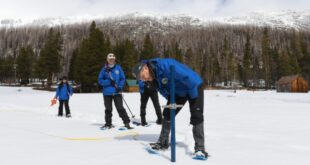It’s official! The 2016-17 water year has now outpaced all other water years in the past 97 years of record keeping posting 89.7 inches of rain and snowmelt, as recorded by eight weather stations from Shasta Lake to the American River basin. Precipitation has been continuously monitored at the eight stations since 1920; this year’s precipitation has now formally surpassed the previous record of 88.5 inches as recorded for the entire Water Year 1982-83. With five-and-a-half more months yet to go in Water Year 2016-17 – and more rain predicted in the coming days especially in Northern California – the final total for this year will continue to be referred to as one for the record books.
The state’s Department of Water Resources (DWR) posted the new record on Thursday even as rain was falling in northern portions of the state. The snow water equivalent (SWE) of California’s snowpack throughout the Sierra Nevada is significantly above average at 176 percent of the April 13 average. The Sierra Nevada’s annual average is approximately 50 inches in contrast to the current almost 90 inches.
Doug Carlson, spokesman for the California Department of Water Resources, put the current precipitation totals into perspective saying, “When we receive a record amount of rainfall in the north, that translates to everybody who benefits from water down the state.”
The abundant rain and snow statewide prompted Gov. Jerry Brown to declare the state’s drought over last week for all but Fresno, Kings, Tulare and Tuolumne counties. Groundwater issues and contaminated wells will necessitate continued water deliveries for many residents in these four counties.
This year’s increased precipitation is primarily attributed to an increase in atmospheric rivers (ARs), the long and relatively narrow “rivers in the sky” laden with moisture that blow in from the Pacific. Traditionally the state gets 30 to 50 percent of its precipitation each year from ARs. From October 1 to March 31, 46 ARs hit the West Coast – 13 of these ARs were classified as “strong” and three were categorized as “extreme.”
Storm damage from these powerful ARs have accounted for millions of dollars of destruction up and down the state. President Donald Trump has approved four separate requests from Gov. Brown for federal emergency funding to deal with the devastating effects of this year’s storms. As of March 16, Marin County had sustained approximately $8.76 million for winter storm-related damages. On March 22 Los Angeles Mayor Eric Garcetti declared a preemptive state of emergency as the state’s snowpack began melting threatening the Owens Valley as well as the aging infrastructure bringing the Sierra Nevada snowmelt to Southern California. Another testimony to the damage caused by this year’s storms is the 34 northern and central coast California counties that will share a $36 million National Dislocated Worker Grant (NDWG) from the U.S. Department of Labor to aid in the recovery and clean-up after this winter’s heavy rain and snow. The department announced it would provide up to $36 million to the California Economic Employment Development Department to help create temporary jobs for some 1,800 people to assist in the effort.
Speaking to the NDWG funds, Joe Versen, a U.S. Department of Labor spokesman said, “This is a disaster-related grant … specifically to create jobs — the disaster-related ones to help with cleanup and recovery following the storm(s).”
Two other multi-station sites for precipitation record-keeping in the state have also announced their most recent statistics. The five-station San Joaquin index is inching toward Water Year 1983’s record total of 77.4 inches; Thursday’s total of 68.2 inches is still significantly outpacing the average of 40.8 inches.
The six-station Tulare Basin index has recorded 45 inches thus far this year versus the region’s average annual precipitation of 29.3 inches or 178 percent of the normal amount. The Department of Water Resources will conduct its last SWE survey for the year on May 1 in the Sierra Nevada at Phillips Station.
 California Water News Daily Your Source For Water News in California
California Water News Daily Your Source For Water News in California


